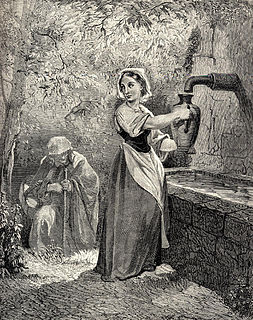Related Research Articles

"Sleeping Beauty", or "Little Briar Rose", also titled in English as "The Sleeping Beauty in the Woods", is a classic fairy tale about a princess who is cursed to sleep for a hundred years by an evil fairy, to be awakened by a handsome prince at the end of them. The good fairy, realizing that the princess would be frightened if alone when she awakens, uses her wand to put every living person and animal in the palace asleep, to awaken when the princess does.

The Pentamerone is a seventeenth-century fairy tale collection by Italian poet and courtier Giambattista Basile.

Diamonds and Toads or Toads and Diamonds is a French fairy tale by Charles Perrault, and titled by him "Les Fées" or "The Fairies". Andrew Lang included it in The Blue Fairy Book. It was illustrated by Laura Valentine in Aunt Louisa's nursery favourite.
The Three Heads in the Well is a fairy tale collected by Joseph Jacobs in English Fairy Tales.

Morozko is a Russian fairy tale collected by Alexander Afanasyev in Narodnye russkie skazki (1855-63). Andrew Lang included it, as "The Story of King Frost", in The Yellow Fairy Book (1894).

"The Three Little Men in the Wood" or "The Three Little Gnomes in the Forest" is a German fairy tale collected in 1812 by the Brothers Grimm in Grimm's Fairy Tales. Andrew Lang included it in The Red Fairy Book (1890) as "The Three Dwarfs," and a version of the tale appears in A Book of Dwarfs (1964) by Ruth Manning-Sanders.
The Two Caskets is a Scandinavian fairy tale included by Benjamin Thorpe in his Yule-Tide Stories: A Collection of Scandinavian and North German Popular Tales and Traditions. Andrew Lang included it in The Orange Fairy Book.
"The Pig King" or "King Pig" is an Italian literary fairy tale written by Giovanni Francesco Straparola in his The Facetious Nights of Straparola. Madame d'Aulnoy wrote a French, also literary, variant, titled Prince Marcassin.
The Enchanted Wreath is a Scandinavian fairy tale, collected in Benjamin Thorpe in his Yule-Tide Stories: A Collection of Scandinavian and North German Popular Tales and Traditions. Andrew Lang adapted a variant of it for The Orange Fairy Book. It is Aarne-Thompson type 403B, the black and the white bride, and includes an episode of type 480, the kind and the unkind girls.
Belle-Belle ou Le Chevalier Fortuné is a French literary fairy tale, written by Madame d'Aulnoy.
The Old Witch is an English fairy tale collected by Joseph Jacobs in his 1894 book, More English Fairy Tales. It is also included within A Book of Witches by Ruth Manning-Sanders and A Book of British Fairy Tales by Alan Garner.
Biancabella and the Snake is an Italian literary fairy tale written by Giovanni Francesco Straparola in The Facetious Nights of Straparola.
Penta of the Chopped-off Hands or The Girl With the Maimed Hands is an Italian literary fairy tale written by Giambattista Basile in his 1634 work, the Pentamerone.
Sapia Liccarda is an Italian literary fairy tale written by Giambattista Basile in his 1634 work, the Pentamerone. It is not known whether he had a specific source, either literary or oral, for this tale.
The Dove is an Italian literary fairy tale written by Giambattista Basile in his 1634 work, the Pentamerone.

Marie-Jeanne L'Héritier de Villandon was an aristocratic French writer and salonnière of the late 17th century, and a niece of Charles Perrault.
Costanza / Costanzo is an Italian literary fairy tale written by Giovanni Francesco Straparola in The Facetious Nights of Straparola.
"The Three Fairies" is an Italian literary fairy tale written by Giambattista Basile in his 1634 work, the Pentamerone.
Aurore and Aimée is a French literary fairy tale written by Jeanne-Marie Le Prince de Beaumont. Like her better known tale Beauty and the Beast, it is among the first fairy tales deliberately written for children.

The Facetious Nights of Straparola, also known as The Nights of Straparola, is a two-volume collection of 75 stories by Italian author and fairy-tale collector Giovanni Francesco Straparola. Modeled after Boccaccio's Decameron, it is significant as often being called the first European storybook to contain fairy-tales; it would influence later fairy-tale authors like Charles Perrault and Jacob and Wilhelm Grimm.
References
- ↑ Jack Zipes, The Great Fairy Tale Tradition: From Straparola and Basile to the Brothers Grimm, p 167, ISBN 0-393-97636-X
- ↑ Jack Zipes, The Great Fairy Tale Tradition: From Straparola and Basile to the Brothers Grimm, p 159, ISBN 0-393-97636-X
- ↑ Golden Legend, see Saints Margaret called Pelagian; Theodora; Marine; and Eugenia